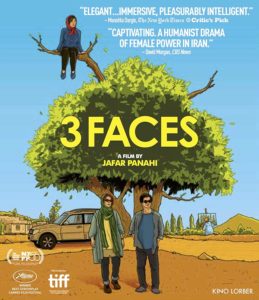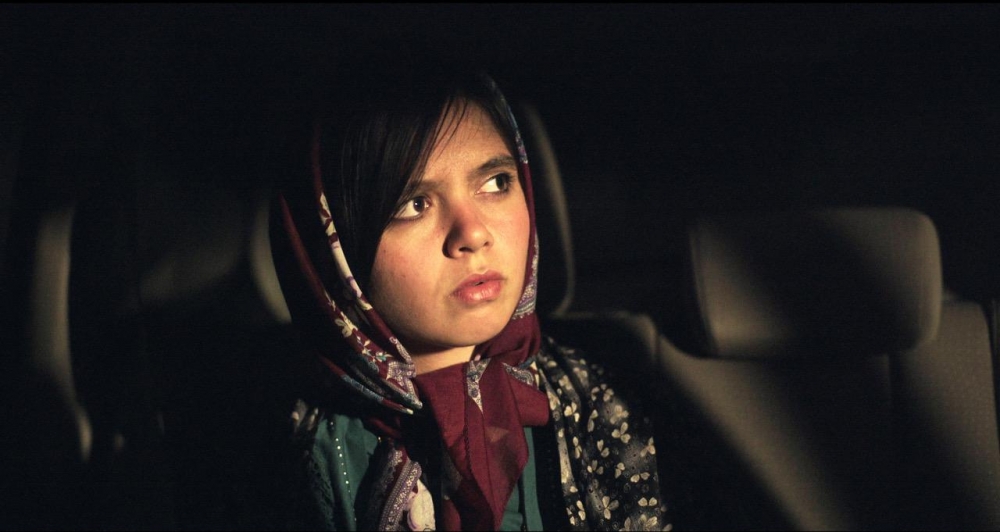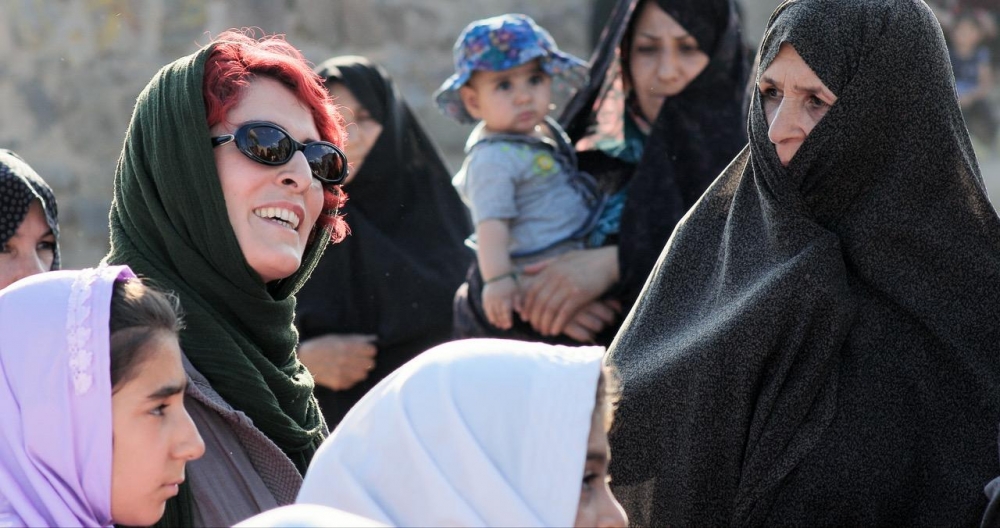An Illegally Made Dark Comedy About the Plight of Women in Iran.
DIRECTED BY JAFAR PANAHI/2019 (U.S. Theatrical Release)
BLU-RAY STREET DATE: JULY 9, 2019/KINO LORBER

This film should not exist. Ever since the accomplished Iranian director Jafar Panahi was imprisoned by his government and barred from filmmaking, he’s been more prolific in making movies than ever. 3 Faces (Se rokh) is his fourth and boldest effort in this circumstantially unfortunate phase of his career. Eluding authorities and hiding his camera in his car for much of the film (also, someone else is always manning the camera, as he appears onscreen, playing himself), Panahi tackles a narrative tale of generational female subjugation in Iran. It’s a wry comedy.
In 2010, fifteen years after he garnered acclaim for becoming the first Iranian director to win the Golden Palm at Cannes (for The White Balloon), Panahi was charged with creating propaganda against Iran’s President Mahmoud Ahmadinejad. If you’re like me, you may remember signing online petitions put forth by the outraged global cinema community. In any case, a slew of well-known directors and film folk signed off in Panahi’s defense.
The good news is, that worked- at least to a point. In what continues to be a long and complicated injustice, the filmmaker remains under house arrest, barred from filming, writing new movies, or giving any interviews to the press. (Although in this Blu-ray package, Kino Lorber includes a short booklet with an interview. Let’s hear it for loophole exploitation and/or outright defiance!).
Why does he do it? Panahi is a filmmaker through and through. He has stated that he simply must make films- even if it ends up costing him his freedom. Though he appears as a key onscreen player throughout his “house arrest” films, with 3 Faces, he turns his focus to the troubled faces of the differently suppressed, fairer gender…

Face 1:
The Youthful Face of Smothered Dreams
An amateur self-shot video of a young Iranian girl transversing a cave-enclosed pathway eventually leads to a noose hanging from an old branch. She steps into it, reinstating her plea one final time… Then, it’s just a snap. The “send” button is somehow hit.
Prior to that, her message is one of complete, last-resort desperation: no one in her family understands her; she’s being forced to marry against her will; all she wants to do Is attend the acting conservatory which will she was accepted to… And only the actress Behnaz Jafari and filmmaker Jafar Panahi can possibly understand and help her. I
Face 2:
The Concerned Face of Defiant Success
The recipient of the ominous video message is real-life actress Behnaz Jafari, playing a distraught version of herself. She must get to bottom of who this mysterious and desperate girl is. She recruits Panahi to help her in her quest, which takes her away from the set of her current project- and she’s needed on set. But Jafari is in no state to work.
As the colorful yet crusty villagers often converge around Jafari due to her recognizability, their own agendas attempt to subvert the mission. “Oh, you’re not here to solve our problems? Then forget you!” The staunch traditionalism of the locals, often veering into bizarre superstition (one old woman is lounging in her own grave plot, listening to the radio and matter-of-factly waiting to croak), is a primary source for the film’s humor. The humor is muted and uneasy, but also essential to the handcrafted milieu of 3 Faces.
Face 3:
The Once-Glorified Face of the Shut-out Nobody
Up a winding pathway, in a terribly tiny shack-like home, there lives a former legend. Before the Iranian Revolution, she was famous, a shining success of Iran’s entertainment industry. Now, those days are over. She is a hermit, a recluse who must be visited for the sake of information on the current case. Who is she? We never quite find out. Jafari must travel into the sad shack on her own, the film’s point of view remaining at the car with Panahi, who waits. My local film critic compatriot, Andrew Wyatt, has pointed out that Panahi is fully aware that this is a women’s story, and is wise enough to step aside and hang back in certain moments. In this case, Panahi’s absence from the visit results in 3 Faces symbolically acknowledging the state of complete lack of identity in which this woman now exists.
*****

With most any film from a foreign culture, there’s bound to be social, political and cultural details that elude the outside viewer simply for lack of local knowledge or experience. 3 Faces is no exception, insomuch as grappling with the current and historic plight of women in Iran is its central thematic concern. That said, 3 Faces will not leave the astute viewer in the dust, nor unrewarded. It is always better to watch such films than not, as the seeds they plant and the internal mysteries they generate are healthy in terms of empathetic curiosity.
For me, my only previous Panahi experience being an anemically attended 2012 festival screening of This is Not a Film, it is legitimately great to catch up with him as he emboldens his approach to his illegal “house arrest” filmmaking. As he explains to interviewer Jamsheed Akrami (the maker of several great documentaries on Iranian cinema, all available together on Kino Lorber’s DVD release of Iranian Cinema: Before and After the Revolution)(And Akrami is presumably not considered “press”, correct…?), Panahi’s sentence is easy for him to elude, since A) the government has seemingly turned a blind eye to his activities, most likely not wanting to stir up any more global outcry that his initial three-month imprisonment of Panahi generated, and B) all anyone really needs to make a film these days is “a laptop and a camera”.
Panahi considers himself blessed on both counts, acknowledging to Akrami that many present-day revolutionaries continue to wither in prison, since they lack his fame. Also, persecuted filmmakers of the past never could’ve worked the way he is currently able to. Only with the advent and proliferation of consumer HD-video smartphones, tiny cameras, and hard drives, can he continue to more boldly explore the home he remains deeply committed to via the art form that he can’t not pursue. With 3 Faces, Panahi turns yet another corner as he shifts the focus from his own cloistering plight and ventures back out into the great big forbidden world.
Kino Lorber’s Blu-ray edition, while short on extras, does provide this visually tactile film for the western masses, complete with a full-color booklet containing the aforementioned Akrami interview. Here’s hoping that more of Panahi’s work can be granted such high-definition treatment, regardless of how low-fi they may’ve originated. These films deserve not to be compressed.
Like the classic work of his late one-time master, Abbas Kiarostami, it’s a world that subtly and constantly mixes its observational amusements with greater harsh realities. A winding one-lane dusty road, being the only way in or out of the remote, featured village, must be transversed via an elaborate system of horn honks, lest you drive into a head-on collision. The metaphor of the road itself is as daunting as its convoluted horn system is comical. With this film, Panahi is content with his current role to remain in the car as the women must make their way forward on the old road, on foot… and together. In such, 3 Faces is a poignant work of acknowledgement and hoped-for advancement of others, and stepping aside to allow for that.

